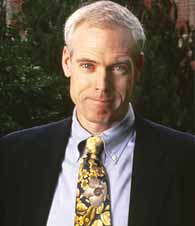|
Executive Interviews: Interview with Jim Collins on Level 5 Leadership
January 2008
 Jim Collins
Jim Collins Founder of Management Laboratory in Boulder, Colorado, 
What separates entrepreneurs who
build great companies from those who
do not?
They make the transition from being
a time teller to become a clock
builder. Time tellers make
everything depend on them, so that
the organization is merely a reflection
of their own personality, but a clock
builder creates an organization that
can deliver great results long beyond
his or her personal influence. Keep in
mind: Sam Walton started with a
single dime store and eventually
built WalMart. He did this because
he made the shift from time telling to
clock building.Put another way,
entrepreneurs who lead as a genius
with a thousand helpers generally
fail to build
|
|
enduring great
companies; you need to build a great
team, not act as the great individual
genius. Do you think it is riskier to try for
greatness? What about the companies
that tried for greatness and failed?
I have two responses to this question.
First, some climbers do indeed die
while trying to climb Mount Everest,
but only those who actually commit to
climbing Mount Everest (whatever the
INTERVIEW 5
risks) do in fact ever reach the
summit. We cannot deny the
possibility that some companies that
try to become great have died along
the way. But so what? We donot find
mere survival to be a very interesting
topic. We are interested in how
companies might attain entrance to
that special category of premier
institutions, and we readily admit that
it might require a risky path to get
there. But and this is my second
response I believe that it is no harder
to build something great than to build
something good. It might be
statistically rare to reach greatness,
but it does not require more suffering
than perpetuating mediocrity. How do you respond to the
criticism that some of the companies
you studied for Good to Great and
Built to Last have struggled in recent
years?
The signature of a truly great entity is
not the absence of difficulty, but the
ability to come back from difficult
times stronger than before. When we
published Built to Last in 1994, IBM
found itself in the middle of a
desperate turnaround, and we endured
derision for including IBM in the book.
Ten years later, IBM had returned as
one of the most significant companies
in the world. Resiliency (not
perfection) is the signature of
greatness, be it in a person, an
organization, or a nation. Yet even if a
few of our companies fail to regain
their prior greatness (which is certainly
possible), that fact alone would not
undermine the fundamental ideas we
derived in our research. Think about it
this way: If we studied healthy people
in contrast to unhealthy people, and
we derived principles of health such
as sound sleep, balanced diet, and
moderate exercise would it
undermine these health principles if
later some of our previously healthy
subjects started sleeping badly, eating
poorly, and not exercising? All that
would say is that some members of the
original study set had ceased to live the
principles that had made them healthy
in the first place. Sleep, diet and
exercise would still hold as principles
of health. How do great companies deal with
the need for change?
Any great social enterprise whether
it be a great company, a great
university, a great religious
institution, or a great nation
exemplifies a duality of continuity
and change. On the one hand, it is
guided by a set of core values and
fundamental purpose that change
little over time, while on the other
hand, it stimulates progress change,
improvement, innovation, renewal
in all that is not part of the core
guiding philosophy. In a great
company, core values remain fixed
while operating practices, cultural
norms, strategies, tactics, processes,
structures, and methods continually
change in response to changing
realities. Lose your core values, and
you lose your soul; refuse to change
your practices, and the world will
pass you by. Those who build the
most iconic and enduring institutions
know the difference between what is
truly sacred and what is not, between
what should never change and what
should be always open for change,
between what we stand for and
how we do things. Youve recently shifted your
attention to nonprofits, with your
monograph Good to Great and the
Social Sectors. What stimulated your
move in this direction?
One day at lunch in Boston, Tom
Tierney of Bridgespan put forth a
challenge: if I had only a few years to
work, what one piece of work should I
do? I paused, and then Tom offered a
suggestion: a piece on the nonprofits
and the social sectors. Tom sent me a
huge stack of information,
highlighting the impending transfer of
wealth into the social sectors and the
need for rigorous thinking and tools to
help the nonprofit leaders build great
organizations. I eventually came to see
that if we only have great companies,
we will merely have a prosperous
society, not a great one. And so I
became a passionately curious
student: how would the good to great
concepts come to life in the context of
nonprofit realities quite different than
business?
1.
Leadership and Entrepreneurship Case Studies
2. ICMR
Case Collection
3.
Case Study Volumes
|
